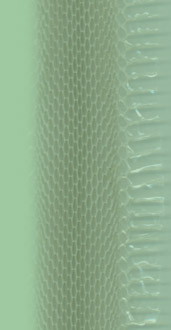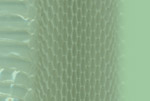









 |
 |
 |
 |
 |
 |

Breeding:
Dasypeltis reach sexual maturity at an age of about two years, if they have been properly fed when young. The best time for mating is after a good meal and right after the female has shed. This does not seem to depend on a particular time of the year, and so far it has always worked for me. The mating act starts with a so-called mating bite. I think that this bite serves two purposes; firstly, it keeps the female from running away, and secondly, it makes copulation easier for the smaller male.
Mating takes much longer with Dasypeltis than with many other snake species. Some 22 hours is quite normal for egg eaters. The female then starts moving through the terrarium, pulling the male along. It really looks quite funny. During the gestation period, the female will continue to consume a number of chicken eggs. Offering a lot of food after she has deposited her eggs has always led to a second, sometimes even a third, clutch with my snakes. My personal record stands at four clutches, even though the last clutch consisted of infertile eggs only.
The shells of Dasypeltis eggs almost always show star-like dots, and are softer than, for example, those of Elaphe spp.. After a gestation period of about one month, the female will lay 6 to 12 eggs, in exceptional cases also more or fewer.
The eggs are incubated for three months at 27 to 29°C during the day and 22 to 24°C during the night. Humidity should be maintained at between 80 and 90%. The incubation substrate for Dasypeltis eggs must not be kept as moist as those of other snakes, as they contract fungal infections quite readily. Substrates such as seramis or vermiculite are much better suited than Sphagnum moss or peat. Depending on the temperatures, the babies will hatch a little earlier or later. I have managed to breed D. fasciata, D. inornata and D. scabra, of which D. scabra produced the stoutest hatchlings. The hatchlings of the other species were only half as thick. The length of a hatchling may range from 14 to 21 cm.
I begin to feed my baby egg eaters only after they have shed for the first time, which happens about two weeks after their emergence. It is common that the youngsters do not take the offered eggs at first, but one should keep on trying, using small eggs like those of Zebra finches. One should also consider alternative options in such a case, like feeding every baby in its own small plastic box, or increasing the humidity in their terrarium a few days before food is offered.
If you keep birds for your own continuous egg supply, you can collect the bird feathers and keep the eggs amongst the feathers for a few hours before feeding so that their scent is transferred to the eggs. A used bird’s nest may also trigger a feeding response. As small as the hatchlings may look, they all have always managed to swallow the eggs of Zebra finches.
With a good supply of small eggs, raising the babies is no problem, as long as they feed on their own. Given these circumstances you can almost watch them grow, and very soon larger eggs, like canary or budgie eggs, are needed. If you only have access to Zebra finch eggs, it is no problem whatsoever, because even adults still feed on such small eggs; they just need more of them. When I still had Zebra finch eggs in abundance and there were no babies to feed, I placed them in the terrarium of the adults and they always ate all of them. I also observed on more than one occasion that they would swallow two eggs at once.
Should nothing bring about the desired result, you will have to force-feed the non-feeders. There are two options to choose from:
1. Either try and push a whole egg into the snake’s mouth, which has almost always been successful with me; or
2. Use a syringe with a plastic catheter and inject the whipped egg into the snake’s stomach.
Once you have started force-feeding you should go on with it and do it religiously every other week, because these juveniles do not grow as fast as those that eat on their own. Force-fed snakes also gain weight more slowly because of the stress caused by the force-feeding.
One should always continue to offer entire fresh eggs in between, because so far all of my snakes have earlier or later learned to feed on their own. The amount of egg content to be fed via a syringe should equal that contained in one Zebra finch egg; excessive amounts will inevitably lead to the death of the baby.
A note about „later“.
Two of my D. fasciata had to be force-fed over three years, until they eventually started to feed on their own. So – never give up!


